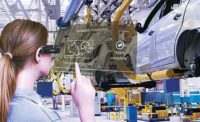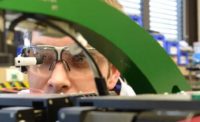Augmented reality (AR) and virtual reality (VR) are cutting-edge tools that are becoming increasingly important to engineers for applications ranging from product design to assembly line layout.
AR adds a layer of computer-generated enhancements to the real world, while VR immerses users in a computer-generated environment. To expose students to the latest AR and VR technology, Rensselaer Polytechnic Institute (RPI) recently opened the Rensselaer Augmented and Virtual Environment (RAVE) laboratory.
“Virtual and augmented reality can be used to perform experiments and provide learning experiences that were previously impossible due to scale, cost or safety,” says Rich Radke, a professor of electrical, computer and systems engineering who serves as co-director of RAVE. “RAVE presents unprecedented opportunities for how we study and incorporate this technology at RPI.
“Being able to reach out, grab something, move it around and twist it is a much different feeling than doing it with a mouse and keyboard,” explains Radke. “Even though the underlying technology may be similar in terms of how you get the 3D rendering on the screen, the human-scale element of seeing this thing floating in front of you and being able to pull it and push it around is really cool. That kind of experiential learning is something that we hope will add to our classes.”
“RAVE was created to incubate and test ideas surrounding the use of AR and VR for both teaching and research,” adds Jason Hicken, associate professor of mechanical, aerospace and nuclear engineering, and co-director of RAVE. “We hope [it] offers a place where [people] can create immersive experiences that are difficult or impossible to achieve in a lab or classroom setting.”
For example, Hicken says students in the nuclear engineering program can experience what is going on within a nuclear reactor; chemical engineers can manipulate molecules at the atomic scale; and aerospace engineers can “walk” through an operating turbofan engine.
“What really excites us as far as the teaching side of this goes is the potential to offer students experiences that were previously impossible but that could really enhance learning,” says Hicken.
One recent RAVE project involved aircraft wing design. By using VR technology, students were able to experience how wind and wing shape can affect the drag experienced by an airplane.
“It started as a collaboration with the Games and Simulations Arts and Sciences program,” Hicken points out. “The goal was to have aerospace students, who were taking an aerodynamics class, learn about a particular kind of drag and how different geometric parameters on the wing impact this type of drag.
“It was a great collaboration where we had a graduate student from the School of Humanities, Arts and Social Sciences and an undergraduate from the School of Engineering [work] together to make this really unique thing,” adds Hicken.
The lab’s large, open space and moveable furniture enables students to safely move about while they’re immersed in mixed reality environments. The state-of-the-art facility features Oculus and Vive headsets, in addition to several high-end PCs for running software.
“We have all of the latest generation phones you can put into VR headset holders, as well as standalone VR headsets that you don’t need a phone to operate,” says Radke. “In addition to the phones, we have different kinds of tablets for experiencing augmented reality, in addition to a couple of Microsoft HoloLenses for hands-free AR. We also have several kinds of cameras for VR environment acquisition.
“We are only beginning to discover RAVE’s potential,” claims Radke. “There’s currently an open call for student research project ideas. Faculty members have also come to us with different ideas related to their research projects that they want to be able to start to explore.”



